xxxxxAs we
have seen, the British occupied Egypt following the Anglo-Egyptian
War of 1882, but
they were determined not to become involved in the affairs of the
Sudan, then under Turko-Egyptian rule. However, when a
rebellion in that country began to grow in strength - started
in 1881 by a religious fanatic named Muhammad Ahmad - the
British government became concerned. By the end of 1883 this
charismatic leader, claiming to be the Mahdi (the messianic redeemer
of the Islamic faith) had gained control over much of the Sudan, and
had roundly defeated an Anglo-Egyptian army at the Battle of El
Obeid. As a result, the British government persuaded the Khedive of
Egypt to withdraw his garrisons from his vassal state, and appointed
General Charles “Chinese” Gordon, a man who had been governor
general of the Sudan, to carry out this task.
On arriving at the capital, however, he strengthened the capital’s
defences, and in March 1884 the Mahdi laid siege to the city. To
meet this threat Gordon called for reinforcements, but the
government remained unwilling to support a military intervention.
Eventually, after a public outcry, it sent a relief column,
commanded by General Lord Garnet Wolseley, but this was delayed by
the Battles of Abu Klea and Abu Kru, and arrived two days too late.
On January 25th 1885
the Mahdi broke into Khartoum and the entire garrison, including
Gordon, was slaughtered. As we shall see, the British returned to
the Sudan in the mid-1890s, and their victory at the Battle of
Omdurman in 1898
was seen to avenge the tragic event of January 1885.
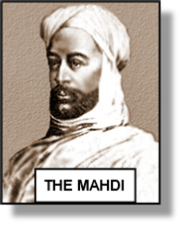 xxxxxItxwas a year before the outbreak of the Anglo-Egyptian
War which, as we have seen, took place in 1882, that a serious rebellion erupted in the
neighbouring state of Sudan. A charismatic religious fanatic named
Muhammad Ahmad
(1845-1885) (illustrated), claiming to be the Mahdi,
the messianic redeemer of the Islamic faith, led a zealous revolt
against the harsh rule of their foreign masters, the Egyptians and
their Turkish overlords. Burdened as the Sudanese were by heavy
taxes and the cruelty of a repressive regime, he gradually won over
the tribes of west and central Sudan and eventually gained
sufficient strength to take on the military might of the Turko-Egyptian
government. InxNovember
1883 the Ansar - the Mahdi’s
devout followers - overwhelmed an Anglo-Egyptian army of
some 8.000 near El Obeid
in central Sudan, thereby gaining valuable equipment. ThexEnglish commander, General
William Hicks (1830-1883) and all
his senior officers were killed, and barely 500 men managed to
escape the massacre.
xxxxxItxwas a year before the outbreak of the Anglo-Egyptian
War which, as we have seen, took place in 1882, that a serious rebellion erupted in the
neighbouring state of Sudan. A charismatic religious fanatic named
Muhammad Ahmad
(1845-1885) (illustrated), claiming to be the Mahdi,
the messianic redeemer of the Islamic faith, led a zealous revolt
against the harsh rule of their foreign masters, the Egyptians and
their Turkish overlords. Burdened as the Sudanese were by heavy
taxes and the cruelty of a repressive regime, he gradually won over
the tribes of west and central Sudan and eventually gained
sufficient strength to take on the military might of the Turko-Egyptian
government. InxNovember
1883 the Ansar - the Mahdi’s
devout followers - overwhelmed an Anglo-Egyptian army of
some 8.000 near El Obeid
in central Sudan, thereby gaining valuable equipment. ThexEnglish commander, General
William Hicks (1830-1883) and all
his senior officers were killed, and barely 500 men managed to
escape the massacre.
xxxxxThe British
looked on with concern. From the time of their conquest of Egypt
in September 1882 they had insisted that Sudanese affairs were a
domestic matter for the Khedive. However, In view of the
deteriorating situation in this vast country, in December 1883 the
British government, led by prime minister William Gladstone -
a man opposed to rash colonial ventures - persuaded the
Khedive to withdraw his garrisons and leave the Sudan to its fate.
Any military involvement, it was argued, would prove very
difficult, time consuming, and highly expensive. To carry out this
task of disengagement the government chose General
Charles Gordon (1833-1885), a man
who had distinguished himself in earlier campaigns - notably
during the Taiping Rebellion in China - and for five years,
beginning in 1876, had served as governor-general of the
Sudan.
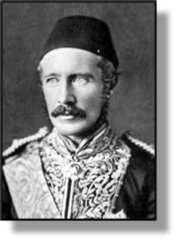
xxxxxIn view of
Gordon’s knowledge of the country, the choice might appear to be a
good one. But it was perhaps a little questionable to ask a man
who had done so much to develop the Sudan to preside over its
downfall. Certainly in a letter to The Times
in January 1884, just before leaving to take up his appointment,
Gordon (illustrated here) made it clear that in his view the correct strategy
would have been to defeat the Mahdi in order to avoid the
possibility of a threat to Egypt itself. This aggressive policy was
supported, among many others, by General Lord Garnet Wolseley.
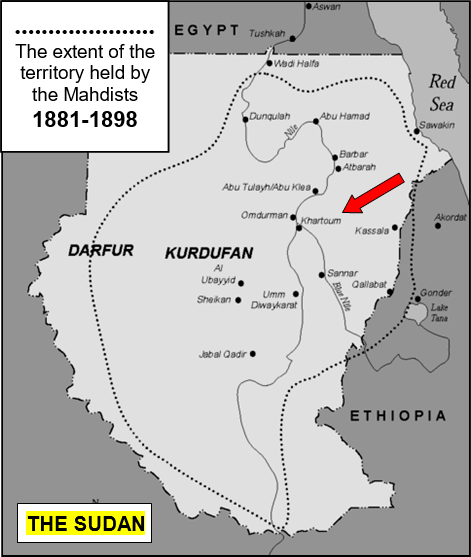 xxxxxOn arrival at Khartoum (arrowed on map),
Gordon was warmly welcomed as the saviour of the city and in many
respects he acted the part. In the early days he did manage to
evacuate 2,500, including many women and children, but he spent most
of his time improving and extending the city’s defences. He provided
gun boats to patrol the Blue and White Nile to the north and west,
and in the south - open to the desert - he built an
elaborate system of trenches, set up wire entanglements, and laid
down land mines. At various times he
asked for troop reinforcements - including a regiment of
Turkish soldiers, a unit of Indian troops and 200 British infantry -
but on each occasion he was refused. Determined to “smash up” the
Mahdi, he then complained bitterly that the government was
“abandoning the garrisons” (such as those besieged at Sennar, Tokar
and Sinkat). This claim attracted a deal of support at home, and
almost brought down the government, but the cabinet refused to be
pushed into what it saw as military intervention.
xxxxxOn arrival at Khartoum (arrowed on map),
Gordon was warmly welcomed as the saviour of the city and in many
respects he acted the part. In the early days he did manage to
evacuate 2,500, including many women and children, but he spent most
of his time improving and extending the city’s defences. He provided
gun boats to patrol the Blue and White Nile to the north and west,
and in the south - open to the desert - he built an
elaborate system of trenches, set up wire entanglements, and laid
down land mines. At various times he
asked for troop reinforcements - including a regiment of
Turkish soldiers, a unit of Indian troops and 200 British infantry -
but on each occasion he was refused. Determined to “smash up” the
Mahdi, he then complained bitterly that the government was
“abandoning the garrisons” (such as those besieged at Sennar, Tokar
and Sinkat). This claim attracted a deal of support at home, and
almost brought down the government, but the cabinet refused to be
pushed into what it saw as military intervention.
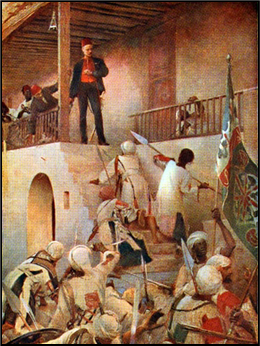 xxxxxThexten-month Siege of Khartoum began in
March 1884. The Mahdi force then besieging the city was put at
30,000, but it was increasing daily, and at Suakin in east Sudan
Egyptian troops were being repeatedly defeated. A British force
was sent, in fact, to hold back the rebels in that area, but in
April 1884, after severe fighting, this was withdrawn and, save
for Khartoum, the Sudan was abandoned. The city, with a civilian
population alone of 34,000, had enough food for just six months.
Two attempts were made to break out, in March and September, but
both failed and suffered heavy loses. By then the tribes to the
north had risen in support of the Mahdi and this more than doubled
the attacking force.
xxxxxThexten-month Siege of Khartoum began in
March 1884. The Mahdi force then besieging the city was put at
30,000, but it was increasing daily, and at Suakin in east Sudan
Egyptian troops were being repeatedly defeated. A British force
was sent, in fact, to hold back the rebels in that area, but in
April 1884, after severe fighting, this was withdrawn and, save
for Khartoum, the Sudan was abandoned. The city, with a civilian
population alone of 34,000, had enough food for just six months.
Two attempts were made to break out, in March and September, but
both failed and suffered heavy loses. By then the tribes to the
north had risen in support of the Mahdi and this more than doubled
the attacking force.
xxxxxIn England
there was an ever growing demand for the sending of a relief
force. Eventually in July the cabinet put plans in motion, but it
took several months to set up, and it did not enter the Sudan
until January. It was then attacked at Abu Klea on January 17th
and two days later at Abu Kru. Commanded by General Lord Garnet
Wolseley, the column repelled both assaults, but this only spurred
on the Mahdi to press home his attack on the besieged city. The
attack was mounted on the night of January 25th 1885.
The Nile was low in water and this enabled the city to be
approached from both north and south. Entrance was gained in the
early hours of the morning and the whole garrison - about
7,000 - was slaughtered, together with 4,000 inhabitants.
Many others were captured and taken into slavery. There was
sporadic resistance, but the men were too tired and hungry to put
up much of a fight. It is not known how Gordon met his death. The
popular version is that, defiant to the end and dressed in full
uniform, he was killed on the steps of his residence (illustrated here by the Irish artist George W. Joy 1844-1925). It is known, however, that he was beheaded and his
head, after being presented to the Mahdi, was put on public display.
The advanced party of the relief column arrived within sight of the
city two days later. The surviving British and Egyptian troops then
withdrew from the Sudan and left Muhammad Ahmed in control of the
entire country. He died a few months later, but not before he had
established a religious state, the Mahdiyah, based on Islamic Sharia
Law.
xxxxxIn the wake
of the disaster General Gordon was seen as a hero and a martyr.
The British press blamed Gladstone for the debacle, arguing that
he should have sent a relief column earlier. Possibly so, though
it is likely that it would only have served to bring forward the
attack on the beleaguered city. Gordon’s conduct must also be
questioned. His stubborn desire to take on the Mahdists somewhat
coloured his judgement, and tended to divert his attention from
his appointed task. With hindsight, however, it might well be said
that, given the circumstances then prevailing in the Sudan in
1884, the task set by the government and assigned to Gordon was
not achievable. Gladstone’s government fell the following June,
but he was returned to office the next year.
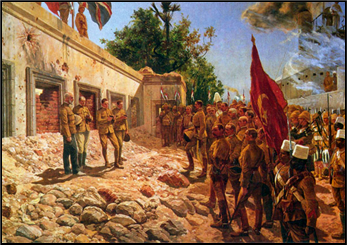
xxxxxAs we shall
see, in the mid-1890s the British were back in the Sudan. The
Battle of Omdurman in 1898, when the bulk of the Mahdist army was roundly
defeated, might be seen as the settling of old scores, but there
were, of course, more pressing reasons for Britain’s return to
this vast territory. Nevertheless, the tragedy of January 1885 was
not forgotten. Two days after Omdurman a memorial service for
Gordon was held in front of the ruins of the palace where he was
brutally killed (here illustrated).
xxxxxIncidentally, “Gordon of Khartoum” was born in Woolwich, London,
in 1833, and educated at the Royal Military Academy there. As a
young man he fought in the Crimean War, taking part in the siege
of Sevastopol in 1854-5. The square in the centre of Woolwich
is named after him. ……
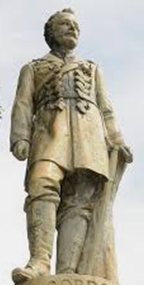 xxxxx…… There are many statues
and memorials to him at home and abroad. He is especially
remembered in Gravesend, Kent, (illustrated), where, after returning from his gallant service in
China in 1865, he worked improving the river defences. A devout
Christian with a strong social conscience, he spent his leisure time
working for a number of local charities and visiting the sick and
elderly. ……
xxxxx…… There are many statues
and memorials to him at home and abroad. He is especially
remembered in Gravesend, Kent, (illustrated), where, after returning from his gallant service in
China in 1865, he worked improving the river defences. A devout
Christian with a strong social conscience, he spent his leisure time
working for a number of local charities and visiting the sick and
elderly. ……
xxxxx…… The Scottish author Arthur Conan Doyle paid tribute
to Gordon in The Adventure of the Empty House, one of his Sherlock Holmes
stories. In the novel he describes the palace where he was killed.
And the English writer Lytton Strachey takes Gordon as one of his
biographies in his famous work Eminent
Victorians, first published in 1918.



 xxxxxItxwas a year before the outbreak of the Anglo-
xxxxxItxwas a year before the outbreak of the Anglo-
 xxxxxOn arrival at Khartoum (arrowed on map),
Gordon was warmly welcomed as the saviour of the city and in many
respects he acted the part. In the early days he did manage to
evacuate 2,500, including many women and children, but he spent most
of his time improving and extending the city’s defences. He provided
gun boats to patrol the Blue and White Nile to the north and west,
and in the south -
xxxxxOn arrival at Khartoum (arrowed on map),
Gordon was warmly welcomed as the saviour of the city and in many
respects he acted the part. In the early days he did manage to
evacuate 2,500, including many women and children, but he spent most
of his time improving and extending the city’s defences. He provided
gun boats to patrol the Blue and White Nile to the north and west,
and in the south - xxxxxThexten-
xxxxxThexten-
 xxxxx…… There are many statues
and memorials to him at home and abroad. He is especially
remembered in Gravesend, Kent, (illustrated), where, after returning from his gallant service in
China in 1865, he worked improving the river defences. A devout
Christian with a strong social conscience, he spent his leisure time
working for a number of local charities and visiting the sick and
elderly. ……
xxxxx…… There are many statues
and memorials to him at home and abroad. He is especially
remembered in Gravesend, Kent, (illustrated), where, after returning from his gallant service in
China in 1865, he worked improving the river defences. A devout
Christian with a strong social conscience, he spent his leisure time
working for a number of local charities and visiting the sick and
elderly. ……

